#Nairobi National Museum
Explore tagged Tumblr posts
Text
Karibu (Welcome), Nairobi

View On WordPress
0 notes
Text
10 Most Popular Destinations in Africa
Looking for the 10 Most Popular Destinations in Africa this year? You’re in the right place. Africa is a vast and diverse continent with many unique and interesting destinations to explore. From bustling cities to natural wonders and ancient landmarks, there is something for everyone to enjoy. Whether you’re a first-time visitor to Africa or an experienced one, here are the top 10 most popular…

View On WordPress
#Addis Ababa visit#Africa#African safari#Cape Town travel#Egypt#Egyptian pyramids#Ethiopia#Johannesburg attractions#Kenya#Koutoubia Mosque#Luxor sightseeing#Marrakech holiday#Mombasa tourism#Morocco#Nairobi National Museum#Nairobi tours#South Africa#Table Mountain#Tunis trip#Tunisia#Victoria Falls vacation#Zimbabwe
0 notes
Text
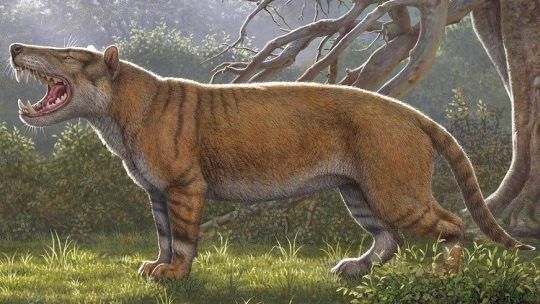

October's Fossil of the Month - Simbakubwa (Simbakubwa kutokaafrika)
Family: Hyena Cat Family (Hyainailouridae)
Time Period: 23-22 Million Years Ago (Early Neogene)
Currently known only from fossilised teeth and lower jaws discovered in Kenya's Messa Bridge fossil site, Simbakubwa kutokaaffrika was originally described as a prehistoric species of hyena before reexamination of fossils housed at the Nairobi National Museum of Kenya led to it being reclassified as a hyaenadont (a member of the extinct order Hyaenadonta, the members of which were generally dog-like animals with similar jaws and teeth to modern hyenas, although their teeth differed from true carnivorans today in that they lacked modified molars used for crushing and tearing seen in animals such as bears and dogs, and seemed to grow their teeth in slower than most modern carnivores.) While the limited variety of Simbakubwa fossils means that much of its biology is a mystery, it is notable among the hyaenadonts because of its size; estimates of its body size based on the size of its jaws suggest that, while most hyaenodonts were comparable to a large dog in size, it was at least as large as a lion, with the most generous estimates suggesting that it may have weighed as much as 1,500kg/3,307lbs (surpassing even modern Polar Bears in size,) although as the more complete fossils of related species suggest that members of the "hyena-cat" family of hyaenodonts that Simbakubwa belonged to had extremely large heads compared to their bodies it is unlikely that it actually reached such as size. Based on the shape of its teeth and the presumed strength of its jaws it is likely that Simbakubwa was purely carnivorous and fed on large mammals such as rhinoceros and gomphotheres (extinct relatives of modern elephants,) although based on the lack of any preserved teeth showing adaptations for crushing it is unclear if members of this species also fed on bones as other hyaenodonts and modern hyenas are known to do. While the circumstances of Simbakubwa's extinction are unclear, it is plausible that as the earth gradually became cooler and drier as it approached a series of "ice ages" in the later neogene resources became scarcer and large carnivores were among the first species to be affected by this. While the binomial names of most species are derived from Greek and/or Latin, Simbakubwa kutokaaffrika is Swahili, translating roughly to "great lion from Africa."
--------------------------------------------------------------------------
*Note - The second image above shows a Simbakubwa lower jaw (bottom) compared to a modern Lion skull (top.)
Image Sources: https://commons.wikimedia.org/wiki/File:Simbakubwa-kutokaafrika_2.jpg
and
https://www.nationalgeographic.com/science/article/new-species-ancient-carnivore-was-bigger-than-polar-bear-hyaenodonts
#Simbakubwa#hyeanodont#hyaenodonts#zoology#biology#paleontology#mammalogy#prehistoric wildlife#animal#animals#wildlife#African wildlife#African fossils#fossil#fossils#mammal#mammals#prehistoric animals#prehistoric mammals
254 notes
·
View notes
Text
King Charles III and Queen Camilla will undertake a State Visit to Kenya
The visit will take place from Tuesday 31st October to Friday 3rd November 2023, and will celebrate the warm relationship between the two countries and the strong and dynamic partnership they continue to forge.
The visit is at the invitation of President Ruto and comes as Kenya prepares to celebrate 60 years of independence. His Majesty’s first visit to a Commonwealth nation as King is therefore to the country in which Queen Elizabeth II’s reign began, having acceded to the throne in Kenya in February 1952.
The King and Queen will visit Nairobi City County, Mombasa County and surrounding areas. Their Majesties’ programme will reflect the ways in which Kenya and the United Kingdom are working together, notably to boost mutual prosperity, tackle climate change, promote youth opportunity and employment, advance sustainable development and create a more stable and secure region.
During the visit, Their Majesties will meet President Ruto and the First Lady as well as and other members of the Kenyan Government, UN staff, CEOs, faith leaders, young people, future leaders and Kenyan Marines training with UK Royal Marines. The King will also attend an event to celebrate the life and work of the Nobel Laureate the late Professor Wangari Maathai, together with Wangari’s daughter, Wanjira Mathai.
The King and Queen’s programme will celebrate the close links between the British and Kenyan people in areas such as the creative arts, technology, enterprise, education and innovation. The visit will also acknowledge the more painful aspects of the UK and Kenya’s shared history, including the Emergency (1952-1960). His Majesty will take time during the visit to deepen his understanding of the wrongs suffered in this period by the people of Kenya. Together, Their Majesties will tour a new museum dedicated to Kenya’s history and will lay a wreath at the Tomb of the Unknown Warrior at Uhuru Gardens, as well as visiting the site of the declaration of Kenya’s independence in 1963.
The King and Queen’s programme also will include:
Their Majesties will be greeted in Nairobi with a ceremonial welcome at State House and will each attend bilateral meetings – The King with The President and The Queen with the First Lady, before The President hosts a State Banquet at State House.
His Majesty will visit the United Nations Office at Nairobi, to learn more about the work of UN Habitat and the UN Environment Programme. UNON is the only UN Headquarters in the Commonwealth.
His Majesty will attend a technology showcase, meeting Kenyan entrepreneurs who are driving forward innovation in the country’s tech sector. Kenya has the third largest start up eco-system in Africa.
His Majesty will host a reception focussed on Kenya’s young people and future leaders across development, trade, media, the creative arts and environmental conservation.
Their Majesties will visit a Commonwealth War Graves Commission cemetery, joining British and Kenyan military personnel in an act of Remembrance, before hearing about the Commission’s recent work to ensure all those who supported Britain’s efforts in both World Wars are commemorated.
The King and Queen will visit Nairobi National Park to witness the vital conservation work being undertaken by the Kenya Wildlife Service, which is integral to Kenya’s thriving tourism industry.
Her Majesty, Patron of the equine welfare charity Brooke, will hear how the charity is working with the Kenya Society for the Protection and Care of Animals to rescue donkeys at risk and promote their welfare.
The King, as Captain General of the Royal Marines, and The Queen, will visit Mtongwe Naval Base in Mombasa. There, Their Majesties will witness Kenyan Marines, trained by the Royal Marines, demonstrating a covert beach landing, showing defence collaboration in action.
The Queen will meet survivors of sexual and gender-based violence, learning how they are supported and sharing her own insights from working in this area.
The King will meet faith leaders from Mombasa’s diverse community, hearing how they are working together to promote harmony amongst the city’s population.
44 notes
·
View notes
Text



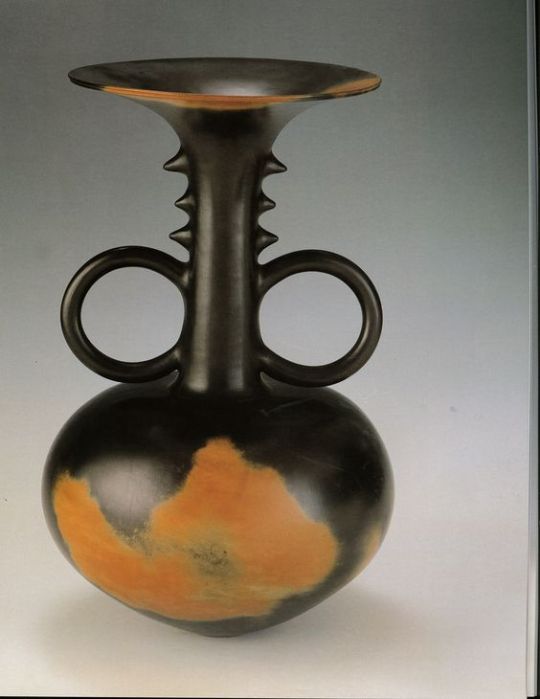





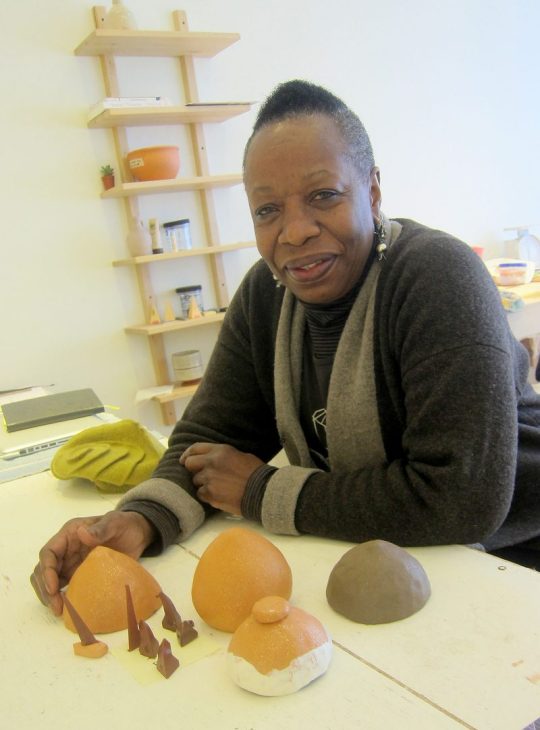
Magdalene Odundo (born 1950) is a Kenyan-born British studio potter, who now lives in Farnham, Surrey. Her work is in the collections of notable museums including the Art Institute of Chicago, The British Museum, The Metropolitan Museum of Art, and the National Museum of African Art.
She has been Chancellor of the University for the Creative Arts since 2018.
Magdalene Odundo was born in Nairobi, Kenya, and received her early education in both India and Kenya. She attended the Kabete National Polytechnic in Kenya to study Graphics and Commercial Art and later moved to England in 1971 to follow her chosen vocation in Graphic Design. After training in Farnham, Surrey, she completed her qualifications in foundation art and graphics at the Cambridge School of Art, where she began to specialise in ceramics.
After a while in England she discovered pottery, and in 1974–75 she visited Nigeria, visiting the Pottery Training Centre in Abuja, and Kenya to study traditional hand-built pottery techniques. She also travelled to San Ildefonso Pueblo, New Mexico, to observe the making of black-burnished vessels.
Odundo's best-known ceramics are hand built, using a coiling technique. Each piece is burnished, covered with slip, and then burnished again. The pieces are fired in an oxidizing atmosphere, which turns them a red-orange. A second firing in an oxygen-poor (reducing) atmosphere causes the clay to turn black; this is known as reduction-firing. She uses the same types of techniques used by the Ancient Greeks and Romans and likes to take inspiration from countries such as China and Mexico. (from wikipedia)
43 notes
·
View notes
Text










A few of the Affordable Art Show.ke entries for the next edition to be held in May at the National Museum, Nairobi, Kenya.
2 notes
·
View notes
Text
Top 20 Most Beautiful Cities In Africa | Travel Tips
Certainly! Africa is a continent known for its diverse landscapes, rich cultures, and vibrant cities.
You may choose to watch Top 10 Most Beautiful Cities In Africa | Best Places
youtube
Here's a list of 20 of the most beautiful cities in Africa, each offering its own unique charm and appeal:
Cape Town, South Africa: Nestled between the iconic Table Mountain and the Atlantic Ocean, Cape Town boasts stunning natural scenery, vibrant neighborhoods, and a rich cultural heritage.
Marrakech, Morocco: Marrakech mesmerizes visitors with its bustling souks, intricate architecture, and the vibrant colors of the Jardin Majorelle.
Nairobi, Kenya: As the gateway to East Africa, Nairobi blends modernity with wildlife conservation, offering attractions like Nairobi National Park and the Karen Blixen Museum.
Fes, Morocco: Fes is a UNESCO World Heritage Site renowned for its medieval medina, elaborate mosques, and labyrinthine alleyways.
Cairo, Egypt: Cairo is a bustling metropolis steeped in history, home to ancient wonders like the Pyramids of Giza and the Sphinx, as well as vibrant markets and lively streets.
Zanzibar City, Tanzania: The old Stone Town of Zanzibar City is a UNESCO World Heritage Site, featuring ornate doors, winding alleys, and beautiful beaches.
Luanda, Angola: Luanda is a coastal city with a mix of Portuguese colonial architecture and modern skyscrapers, offering stunning seaside views and a vibrant nightlife.
Johannesburg, South Africa: Johannesburg is a dynamic city known for its cultural diversity, thriving arts scene, and historical sites like the Apartheid Museum.
Dakar, Senegal: Dakar is a lively coastal city with colorful markets, vibrant music scene, and stunning beaches like Yoff Beach and N'Gor Beach.
Cape Coast, Ghana: Cape Coast is known for its picturesque beaches, colonial architecture, and its historic role in the transatlantic slave trade, evidenced by landmarks like Cape Coast Castle.
Asmara, Eritrea: Asmara boasts a unique blend of Italian colonial architecture, modernist buildings, and palm-lined boulevards, earning it recognition as a UNESCO World Heritage Site.
Windhoek, Namibia: Windhoek is a city surrounded by breathtaking landscapes, offering visitors a blend of German colonial architecture, lively markets, and nearby safari adventures.
Kigali, Rwanda: Kigali is a clean and green city known for its orderly streets, cultural attractions like the Kigali Genocide Memorial, and stunning views of the surrounding hills.
Accra, Ghana: Accra is a vibrant capital city with lively markets, beautiful beaches, and historical landmarks like Independence Arch and Jamestown.
Lagos, Nigeria: Lagos is a bustling megacity with a vibrant atmosphere, offering a mix of beaches, bustling markets, and a thriving arts and music scene.
Addis Ababa, Ethiopia: Addis Ababa is a city of contrasts, blending modern skyscrapers with traditional Ethiopian architecture, vibrant markets, and cultural attractions like the National Museum.
Maputo, Mozambique: Maputo is a coastal gem with a laid-back atmosphere, colonial-era architecture, vibrant markets, and stunning ocean views along its scenic waterfront.
Stone Town, Zanzibar: Stone Town is the historic heart of Zanzibar, known for its narrow streets, ornate doors, and rich Swahili culture, offering a glimpse into the island's past.
Gaborone, Botswana: Gaborone is a modern city surrounded by natural beauty, offering visitors botanical gardens, wildlife reserves, and a thriving arts and crafts scene.
Abuja, Nigeria: Abuja is Nigeria's modern capital city, known for its impressive architecture, lush greenery, and cultural landmarks like the Nigerian National Mosque and Aso Rock.
Read more
Top 15 Best Places To Visit Tokyo Japan | Tourists Attraction
Top 10 Best Places To Live In UK [ United Kingdom] 2024
Top 10 Best Places To Live In Canada 2024 | Best Cities
Top 10 Best Places to Live in America [ USA Cities ] 2024
How To Make Money : Top 10 Niches To Monetize YouTube
Hillbrow Johannesburg The Vibrant Area Of South Africa
Dubai Downtown Walking Tour 2023 | Burj Khalifa UAE
Dubai Beach: Walking Around | The Best Tour 2023
Ethiopian Airlines Flying Queue At Addis Ababa Airport
3 notes
·
View notes
Text
Things To Do In Narobi
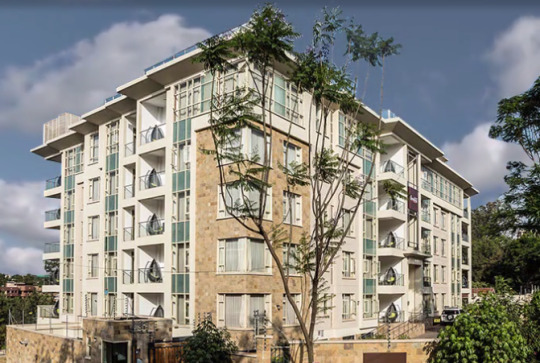
Nairobi, the bustling capital city of Kenya, is a vibrant and diverse destination with a rich cultural heritage and an abundance of wildlife. With its thriving urban center and proximity to incredible natural wonders, Nairobi offers a wide range of attractions and activities that will make your visit truly unforgettable. Whether you're a wildlife enthusiast, a history buff, or a food lover, there's something for everyone in this dynamic city. In this article, we will explore 20 amazing things to do and places to visit in Nairobi, ensuring that your trip is filled with exciting experiences and memorable moments.
Table of Contents
Nairobi National Park
David Sheldrick Wildlife Trust
Giraffe Centre
Karen Blixen Museum
Kazuri Beads Factory Tour
Bomas of Kenya
Karura Forest Reserve
Nairobi National Museum
Kenya National Archives
Nairobi Safari Walk
Now let's dive into the details of each of these incredible attractions and activities!
1. Nairobi National Park
Nairobi National Park is a must-visit destination in Nairobi for wildlife enthusiasts. As Kenya's first national park, it is a unique conservation area that offers a taste of the African wilderness right on the city's doorstep. Just a short drive from the city center, you can immerse yourself in the natural beauty of the park and encounter a wide variety of wildlife.
The park is home to a diverse range of animals, including lions, giraffes, zebras, buffalos, and rhinos. You can embark on a thrilling game drive and witness these magnificent creatures in their natural habitat. The park also offers opportunities for birdwatching, with over 400 bird species recorded in the area.
For a truly unforgettable experience, consider booking a guided tour that will provide you with insights into the park's ecosystem and its conservation efforts. Don't forget to bring your camera to capture the stunning landscapes and wildlife encounters that Nairobi National Park has to offer.
2. David Sheldrick Wildlife Trust
Located near Nairobi National Park, the David Sheldrick Wildlife Trust is a sanctuary for orphaned elephants and rhinos. This renowned conservation organization is dedicated to rescuing and rehabilitating these majestic animals, with the goal of reintroducing them back into the wild.
Visiting the David Sheldrick Wildlife Trust is an incredible opportunity to get up close and personal with baby elephants and learn about their stories of survival. You can watch as they are fed and cared for by dedicated keepers, and even adopt an orphaned elephant to support their ongoing care and conservation efforts.
By visiting the David Sheldrick Wildlife Trust, not only will you have a unique and heartwarming experience, but you will also contribute to the conservation of these endangered species. It's a truly rewarding and educational activity that should not be missed.
3. Giraffe Centre
The Giraffe Centre is another popular attraction in Nairobi that offers a unique opportunity to interact with these graceful creatures. Located within easy reach of the city center, the center is dedicated to the conservation of the endangered Rothschild's giraffe.
At the Giraffe Centre, you can learn about the conservation efforts being made to protect these beautiful animals and even feed them from a raised platform. It's an incredible experience to be eye to eye with a giraffe and witness their gentle nature up close.
In addition to the giraffes, the Giraffe Centre also offers a nature trail where you can explore the surrounding forest and spot various bird species. It's a great way to enjoy the outdoors and connect with nature while in Nairobi.
4. Karen Blixen Museum
For fans of literature and history, a visit to the Karen Blixen Museum is a must. Housed in the former home of the famous Danish author, Karen Blixen (also known by her pen name, Isak Dinesen), the museum offers a glimpse into the life and work of this iconic writer.
Karen Blixen lived in the house from 1917 to 1931, during which time she ran a coffee plantation. The museum showcases her personal belongings, including furniture, photographs, and books, providing a fascinating insight into her life and the colonial history of Kenya.
While exploring the museum, you can also stroll through the beautiful coffee gardens surrounding the property, offering a serene and picturesque setting. It's a wonderful opportunity to step back in time and immerse yourself in the world of Karen Blixen.
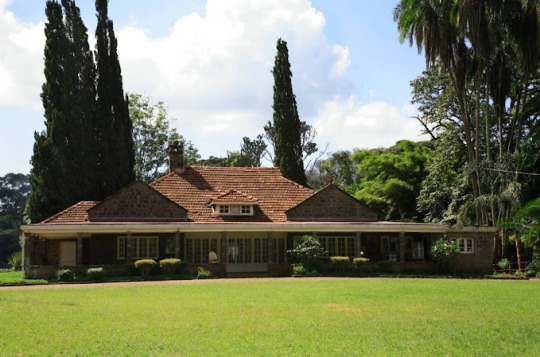
5. Kazuri Beads Factory Tour
If you're looking for a unique shopping experience and a chance to support local artisans, a visit to the Kazuri Beads Factory is highly recommended. This fair-trade business produces beautiful handmade ceramic beads and jewelry, providing employment opportunities for disadvantaged women in Nairobi.
During a factory tour, you can witness the intricate process of bead-making and learn about the social impact of this initiative. The Kazuri Beads Factory is dedicated to empowering women and promoting sustainable livelihoods, making it a meaningful and socially responsible destination.
After thetour In Nairobi , you can browse the wide array of colorful beads and jewelry available for purchase. Whether you're looking for a one-of-a-kind souvenir or a special gift, Kazuri Beads offers a wide range of options that reflect the vibrant culture of Nairobi.
6. Bomas of Kenya
For a taste of traditional Kenyan culture In Nairobi, a visit to the Bomas of Kenya is a must. This cultural center showcases the diverse ethnic groups of Kenya through music, dance, and traditional performances.
At the Bomas of Kenya, you can watch captivating performances that highlight the rich heritage of different tribes, including Maasai, Kikuyu, Luo, and many more. The vibrant costumes, rhythmic music, and energetic dances will transport you to the heart of Kenyan culture.
In addition to the performances, the Bomas of Kenya also features a replica traditional village where you can explore traditional homesteads and learn about the daily life and customs of various tribes. It's a fascinating and immersive experience that offers a deeper understanding of Kenya's cultural diversity.
7. Karura Forest Reserve
If you're in need of a peaceful escape from the bustling city, look no further than the Karura Forest Reserve. Located on the outskirts of Nairobi, this urban oasis offers a tranquil environment for relaxation and outdoor activities.
Karura Forest is one of the largest urban forests in the world, spanning over 1,000 hectares of lush greenery. It features numerous walking and cycling trails, allowing visitors to explore the diverse flora and fauna that call the forest home.
As you wander through the forest, you'll come across beautiful waterfalls, serene lakes, and picnic spots in Nairobi where you can take a break and enjoy the natural surroundings. It's the perfect place to reconnect with nature and recharge your batteries.

8. Nairobi National Museum
For a comprehensive overview of Kenya's rich cultural and natural history, a visit to the Nairobi National Museum is highly recommended. This world-class museum showcases a wide range of exhibits, including archaeology, paleontology, ethnography, and art.
Inside the museum, you'll find fascinating artifacts and displays that offer insights into Kenya's diverse ethnic groups, traditional customs, and contemporary art scene. From ancient fossils to contemporary works of art, the Nairobi National Museum provides a captivating journey through Kenya's past and present.
The museum also features a botanical garden where you can explore and learn about the country's unique plant species. It's a great opportunity to appreciate Kenya's natural beauty and biodiversity.
9. Kenya National Archives
If you're interested in delving deeper into Kenya's history and heritage, a visit to the Kenya National Archives is a must. This archival institution houses a vast collection of documents, photographs, and records that trace the country's development from colonial times to the present day.
Inside the Kenya National Archives, you can explore exhibitions that cover a wide range of topics, including politics, culture, and social issues. The archives provide a valuable resource for researchers and history enthusiasts, offering a glimpse into the country's complex past.
Whether you're interested in genealogy, political history, or cultural heritage, the Kenya National Archives is a treasure trove of information that will deepen your understanding of Kenya's rich and diverse heritage in nairobi.
10. Nairobi Safari Walk
For those who want to experience Kenya's incredible wildlife without venturing too far from the city, the Nairobi Safari Walk is the perfect option. Located adjacent to Nairobi National Park, this unique attraction in Nairobi allows visitors to get up close and personal with various animal species.
The Nairobi Safari Walk features raised wooden boardwalks that wind through different habitats, including wetlands, savannah, and forest. As you stroll along the walkways, you'll encounter a wide range of animals, including lions, cheetahs, rhinos, zebras, and giraffes.
In addition to the animal sightings, the Nairobi Safari Walk also provides educational exhibits and information about conservation efforts in Kenya. It's a fantastic opportunity to learn about the importance of wildlife conservation and the challenges faced by these magnificent creatures.
The Nairobi National Botanic Garden is home to an impressive collection of indigenous plant species, including colorful flowers, towering trees, and delicate ferns. As you stroll through the garden, you'll discover various themed sections, such as the succulent garden, the medicinal plants garden, and the rock garden.
In addition to the plant life, the Nairobi National Botanic Garden is also a haven for birdwatchers, with numerous bird species inhabiting the area. It's a great spot to relax, have a picnic, and appreciate the beauty of Kenya's flora and fauna.

Conclusion
Nairobi, with its vibrant culture, rich history, and incredible wildlife, offers a wide range of attractions and activities for visitors to enjoy. From exploring wildlife parks and sanctuaries to immersing yourself in the city's cultural heritage, there's something for everyone in this dynamic city. Whether you're a nature enthusiast, a history buff, or a food lover, Nairobi will captivate your senses and leave you with unforgettable memories. So, pack your bags and embark on an adventure to discover the 20 amazing things to do and places to visit in Nairobi.
#ApartmentsinNairobiKenya#ExecutiveResidencyNairobi#StayApartmentsinNairobiKenya#Hotel#Stayinnairobi#Placetovisitinnairobi#SafariWalkinnairobi#KaruraForestReserveinnairobi
5 notes
·
View notes
Text
Top 5 Kenya Honeymoon Packages Perfect for Couples
When planning a honeymoon, Kenya stands out as an ideal destination offering breathtaking landscapes, luxurious accommodations, and unforgettable adventures. From iconic safaris to serene beaches, Kenya Honeymoon Packages cater to couples seeking romance and adventure in equal measure. This guide explores the top five Kenya honeymoon packages perfect for couples who want a blend of luxury, serenity, and thrilling experiences.
1. Masai Mara Luxury Safari and Romantic Retreat
The Masai Mara is synonymous with extraordinary wildlife and luxury. This package offers newlyweds the opportunity to experience an intimate safari adventure in one of Kenya’s most famous game reserves.
Couples can stay in opulent tented camps or lodges featuring private verandas and plunge pools. Enjoy game drives to spot the “Big Five,” and end the day with a sundowner overlooking the savannah. This package often includes romantic bush dinners under starry skies, making it a truly magical experience.
2. Diani Beach and Marine Adventure
For couples who dream of sandy beaches and turquoise waters, Diani Beach is a paradise. This package combines relaxation and adventure, offering stays in luxury beachfront resorts with private villas or honeymoon suites.

3. Amboseli Safari with Mount Kilimanjaro Views
Amboseli National Park offers stunning views of Mount Kilimanjaro, creating a picturesque backdrop for a romantic getaway. This Kenya Honeymoon Package focuses on combining luxurious accommodations with exceptional wildlife experiences.
Stay in eco-friendly lodges that provide panoramic views of Kilimanjaro and enjoy private game drives to see large herds of elephants. Honeymooners can also take guided nature walks or enjoy a private breakfast in the bush, adding a personalized touch to the adventure.
4. Samburu Safari and Cultural Experience
For couples seeking a blend of wildlife and cultural immersion, Samburu is the perfect choice. This off-the-beaten-path destination offers unique wildlife sightings, including the Grevy’s zebra, Somali ostrich, and reticulated giraffe.
The package includes stays in luxury lodges with stunning views of the Ewaso Ng’iro River. Honeymooners can enjoy guided game drives, bird-watching excursions, and interactions with the Samburu people to learn about their rich culture and traditions. The combination of nature and culture ensures a memorable and meaningful honeymoon.
5. Nairobi, Lake Naivasha, and Maasai Mara Combo
This comprehensive package combines the best of Kenya’s diverse landscapes. Couples begin their journey in Nairobi, exploring attractions like the Giraffe Centre and Karen Blixen Museum. They then move to Lake Naivasha for romantic boat rides and peaceful moments surrounded by nature.
The adventure concludes in the Masai Mara, where luxury safaris provide an intimate connection with wildlife. This package offers a mix of city, lake, and safari experiences, ensuring couples get the best of Kenya in one unforgettable trip.
Why Choose Kenya for Your Honeymoon?

Moreover, Kenya Luxury Safari Packages ensure a premium experience with top-tier services, personalized touches, and attention to detail, making your honeymoon truly unforgettable.
Kenya offers a variety of honeymoon packages that cater to every couple’s desires, from thrilling safaris to tranquil beach escapes. If you’re ready to embark on your romantic adventure, Bigzone Safaris Africa Limited is your trusted partner.
Contact Us:
Phone: +254 720 888940, +254 780 888941
Email: [email protected]
We serve couples from Nairobi, Mombasa, Kisumu, Nakuru, and other nearby areas. Let us help you create memories that will last a lifetime with our carefully curated Kenya honeymoon packages.
Embark on the journey of a lifetime with your partner and discover why Kenya is a top honeymoon destination for couples worldwide!
#KenyaHoneymoonPackages#LuxurySafariKenya#RomanticKenyaGetaway#KenyaCouplesTravel#HoneymoonInKenya#KenyaLuxurySafari#MasaiMaraHoneymoon
0 notes
Text
Kenya: 5-Day Journey Experiences in the Heart of Africa
Today, I am going to share the journey of 5 days in Kenya. Kenya is one of Africa's most famous travel destinations for tourism that has a rich culture and landscapes. This country is a home of iconic wildlife safaris, beaches, and vibrant cities that are the unique blend of tradition and modernity. If you are seeking adventure or relaxation, Kenya is the best destination because of natural beauty and cultural heritage. In this guide, we will explore five of the most unique places in Kenya, weaving them into a five-day itinerary that gives you an unforgettable experience.
These unique places in Kenya offer unforgettable adventures, but the main question is: How can you go to Kenya? You can enter Kenya with the help of the new system, Kenya eTA. The kenya eta application is a convenient, fast, and efficient way for tourists to gain entry into the country. It allows travelers to apply online, eliminating the need for time-consuming traditional visits. The eTA ensures smooth entry for eligible visitors, providing a stress-free start to your Kenyan adventure. Whether you are heading to Lamu Island or exploring the Maasai Mara, the Kenya eTA makes it easier than ever to experience the magic of this beautiful country.
Spend 5 Days with 5 Unique Places in Kenya
You can plan your 5 days trip to Kenya yourself or with the help of Local guides and Tour agencies by doing online booking.
Day 1: The Beauty of Lamu Island

First day in Kenya, you should go to Lamu Island, which is a UNESCO World Heritage Site, located on the coast of Kenya. This small island is famous for pristine beaches, swahili culture, Dhows and Sailing. You can take a ride and explore the surrounding waters, enjoy sunsets and plan a picnic on the beach. You can go to the Lamu Museum where you can learn the island's history, swahili culture, traditional craftsmanship, and maritime trade routes.
Day 2: Laden Lake Nakuru

This shallow alkaline lake, Laden Lake Nakuru is one of Kenya’s most spectacular natural wonders, located in the Great Rift Valley. Lake Nakuru is famous for bird species and large populations of flamingos. If you are a nature lover then this place is perfect for you because this lake is surrounded by Lake Nakuru National Park, is a home of Rhinos, Lions, Leopards, Buffalo and Giraffes, so you can do wildlife safaris. This place is a dream destination for wildlife photographers, you can visit Makalia Waterfalls within the park.
Day 3: Conquer Mount Kenya

On Day 3, you can go to Mount Kenya which is the highest mountain in Kenya and the second highest peak in Africa. This iconic landmark is a UNESCO World Heritage Site, famous for trekkers. The most popular trails are the Sirimon and Chogoria routes which provide stunning views of surrounding landscapes. Point Lenana is the highest point accessible to trekkers, it is also home of rare plants such as groundsel, giant lobelias, etc. and wildlife including Elephants. Along your trek, you will pass pristine alpine lakes and glaciers that are a part of the mountain’s glacial.
Day 4: Safari Adventures in the Maasai Mara

During the trip to Kenya, you must know No trip would be complete without Maasai Mara safari. Millions of Wildebeest, Zebras, and Gazelles cross the Mara River each year which are part of the Great Migration. It is the best wildlife experience in the world. You can do Hot Air Balloon Safari to see Big five: Lion, Elephants, Leopards, Rhinos, and Buffalo and other animals. If you want to see the Great Migration then you should go between July to October.
Day 5: Nairobi Museums and Giraffe Centre

On the final day of your kenya adventure tour, you must go to Nairobi, which is the capital of Kenya, to explore history and rich culture because this city is a mix of modernity and tradition. In the Nairobi National Museum, You can learn history from its ancient civilizations to its modern-day achievements. It also houses an extensive collection of fossils, including the famous Turkana Boy. After that you should go to the Giraffe Centre which is the home of Rothschild Giraffes, you can feed them and learn about ongoing conservation efforts.
Conclusion
Kenya is a land of diverse landscapes and remarkable beauty, whether you are a wildlife enthusiast, adventurer, or history lover, It provides a perfect blend of relaxation, excitement, and discovery. From the serene beaches of Lamu Island to the towering peaks of Mount Kenya, the flamingo-filled Lake Nakuru to the iconic safaris of the Maasai Mara, the country offers a wealth of unforgettable experiences. Pack your bags and get ready to explore the charm of Kenya.
#evisakenya#kenyaevisa#evisaforkenya#visaforkenya#kenyavisafree#etakenya#visaonarrivalkenya#kenyavisaonarrival#kenyavisarequirements#evisakenyaapplication#kenyaetaapplication#kenyaplacestovisit#placestovisitkenya#uniqueplacestovisitinkenya
0 notes
Text
Unveiling Kenya's Wonders: A Journey Through its UNESCO World Heritage Sites
Explore Kenya's rich history and breathtaking landscapes through its UNESCO-listed sites. Discover ancient ruins, vibrant cultures, and unforgettable wildlife encounters.
UNESCO KENYA’S HERITAGE SITES WONDERS
(African Lion in Masai Mara, Africa.)

Kenya is a land full of nature’s beauty, offering a once-in-a-lifetime adventure. The only place in the world to have a unique opportunity to witness the iconic Big Five wildlife and discover the 7 UNESCO World Heritage sites. Kenya ranks just behind South Africa in Africa for the number of UNESCO-listed sites, highlighting its cultural heritage.
( Map of South Africa highlighting the UNESCO KENYA’S HERITAGE SITES WONDERS with actual images for the sites)

South Africa is home to some of the most breathtaking national parks in the world, offering a unique blend of wildlife, stunning landscapes, and rich biodiversity. The South Africa national parks system, managed by SANParks, encompasses renowned destinations like Kruger National Park, Table Mountain National Park, and Addo Elephant National Park. These protected areas are a haven for adventure enthusiasts, wildlife photographers, and nature lovers. Whether you want to experience thrilling game drives, scenic hiking trails, or peaceful camping under the stars, South Africa's national parks promise unforgettable experiences that connect you with nature in its purest form.

The number of internationals arriving to visit wildlife tourism facilities in Kenya from 2019 to 2022, categorized by visitor type.
The graphs below show the country of origin for international arrivals as of 2023


Significance Of Lake TurkanaTurkana, the saltiest of East Africa's big lakes, is a special place where plants and animals can make a home in a tough environment. Its three national parks are critical breeding grounds for migratory birds and significant breeding grounds for Nile crocodiles, hippos, and venomous snakes.
Koobi Fora Fossils and the World Heritage Status of Lake Turkana National Parks
The Koobi Fora deposits are like treasure chests filled with fossils of mammals, molluscs, and other creatures from long ago. Recognized for their importance, the Lake Turkana National Parks were added to the World Heritage List in 1997. They are now jointly managed by (KWS) and (NMK) Kenya Wildlife Services and The National Museum of Kenya, respectively.
Lake Turkana National Parks
Lake Turkana National Park has been separated into three distinct parks: Sibiloi National Park, South Park and the Central Islands National Parks. Each offers a unique and breathtaking experience. They cover a total area of 161,485 hectares, and these parks are surrounded by a starkly beautiful desert landscape seemingly untouched by time.
( Elephants Roaming in the Grasslands of Sibiloi National Park)

( Satellite View Of Central Islands National Park, Turkana, Kenya)

A Desert Lake of Extraordinary Beauty
Located along the Rift Valley, Lake Turkana stretches 249 kilometres from north to south and 44 kilometres wide at its widest point. The average depth of the river is 30 meters, the fourth largest lake in Africa. Its stunning colour has earned it the nickname "Jade Sea."
Mount Kenya: A Majestic Natural Wonder
Towering over East Africa, Mount Kenya is a breathtaking landscape of rugged glacier-clad peaks and lush forested slopes. Established in 1949, Mount Kenya National Park and Forest have been declared a UNESCO World Heritage Site in 1997 to protect its unique environment and wildlife.
Joint Management
The park has been jointly managed by the Kenya Wildlife (KWS) and The National Museums of Kenya (NMK); the park serves as a vital water catchment area for the region and a crucial habitat for diverse animal species.
(Sunset at Mount Kenya)

Mount Kenya: A Majestic African Peak
Mount Kenya spans the equator approximately 193 kilometres northeast of Nairobi and 480 kilometres from the Kenyan coast. The mountain is the second-highest mountain in Africa. This ancient extinct volcano reaches a towering height of 5,199 meters.
( Image showing different peaks of Mount Kenya, Kenya)
Explore the Beauty of Mount Kenya
Mount Kenya National Park and Forest passes through Africa's majestic second-highest peak and surrounding forested slopes.UNESCO has even called it a World Heritage Site for having the presence of flora and fauna. Explore the park's unique ecosystems by kick starting your hiking and mountaineering adventures, and absorb yourself the rich cultural and historical significance of Mount Kenya.
The table below shows the exciting facts about Mount Kenya


Lamu Old Town: A Timeless Swahili Gem
Nestled on the Kenyan coast, Lamu Old Town is a historical gem known as one of the best-preserved Swahili settlements in East Africa. The town, which dates back to the 14th century, is a UNESCO World Heritage Site, highlighting the town’s deep cultural and architectural heritage of the Swahili people.
( lamu old town kenya)

Explore Historical Landmarks
The Lamu Old Town provides visitors the opportunity to discover various important historical places, including the German Post Office Museum, which opened in 1996, as well as the Lamu Fort.
(German Post Office At Old Time Lamu)

Architectural Heritage and Cultural Unity of the Town
The town is famous for its narrow streets and alleyways that facilitate movement solely on foot or with the help of donkeys. The town's architectural style can be characterized as a mix of Swahili, Arabic, Persian, Indian, and European influences.
A Serene Island Escape
Lamu Old Town is a perfect destination for relaxation and recreational activities because of its calm atmosphere. Relax on the white sandy velvety beaches, explore the lively coral reefs, and soak up the sunlight.
Lamu Old Town has now become one of the few destinations that combines history and culture with natural beauty, offering visitors a truly everlasting experience.
Exploring the Sacred Mijikenda Kaya Forests
The Sacred Mijikenda Kaya Forests: A Cultural and Ecological Heritage
Nestled along Kenya's coastline, the Mijikenda Kaya Forests are a network of 11 sacred forested sites, each representing a unique Mijikenda community. These fortified villages, dating back to the 16th century, serve as repositories of the Mijikenda people's spiritual beliefs and the resting places of their ancestors.
( Sacred Mijikenda Kaya Forests, Kenya)

A Blend of History and Nature
The Kaya forests offer a captivating blend of cultural heritage and natural beauty. Explore these sacred sites adorned with shrines, graves, and initiation grounds, and immerse yourself in the rich traditions of the Mijikenda people.
Discover the diversified varieties of both flora and fauna that grow within these forested havens, including many endemic and endangered species.
A UNESCO World Heritage Site
Recognizing their cultural and ecological significance, the Mijikenda Kaya Forests were officially recognized as a UNESCO World Heritage Site in 2008. The Mijikenda community has taken care of the forests around the Kayas to protect the sacred graves and groves. These forests are now nearly the only remaining parts of the once-large coastal lowland forest.
A Unique and Memorable Experience
Visiting the Mijikenda Kaya Forests is a truly unique and enriching experience. Get involved in the spiritual atmosphere, explore the historical places, and get a chance to learn the rich traditions of Kenya.
Kenya Lake System: A Natural Wonder
The Kenya Lake System in the Great Rift Valley)

A UNESCO World Heritage Site
The Kenya Lake System, nestled within the Great Rift Valley, was recognized as a UNESCO World Heritage Site in 2011. This stunning natural property passes between the three interconnected lakes, Bogoria, Nakuru, and Elementaita, covering a total area of 32,034 hectares.
( Lake Bogoria With Silicone Hot Water Springs From Kenya Lake System)

A Landscape of Geological Marvels
Nature’s forces, such tectonics movement and volcanism, have created a distinctive landscape perfect for adventure.
A Wildlife Haven
The lakes support a remarkable diversity of wildlife, including large mammal populations and a wide range of bird species. Spot black rhinos, Rothschild's giraffes, greater kudus, lions, cheetahs, and wild dogs as they roam freely in their natural habitat.
A Birdwatcher's Paradise
The lake is the most important feeding ground for the lesser flamingo and serves as a vital nesting and breeding site for great white pelicans. The Kenya Lake System is renowned for its exceptional birdlife.
Each year, millions of “lesser” flamingos migrate between these three lakes, making it a perfect spot for bird watching. These lake’s are also home to 13 globally endangered bird species.
A Natural Gem
Surrounded by hot springs, geysers, and the dramatic escarpment of the Rift Valley, the Kenya Lake System offers a truly unforgettable experience.
Fort Jesus: A Historic Landmark
Standing proudly at the southern edge of Mombasa, Fort Jesus is a testament to the Portuguese colonial era. The fort was built in the 16th century during the years 1596-1596; this architectural marvel was a strategic outpost guarding the Indian Ocean trade routes. A UNESCO World Heritage Site since 2011, Fort Jesus reflects the cultural exchange between Africa, Arabia, Turkey, Persia, and Europe.
(Fort Jesus With Cannons In The Forefront At Mombasa)

A Blend of Architectural Styles
Designed by Giovanni Battista Cairati, Fort Jesus showcases the Renaissance ideal of geometric harmony and perfect proportions.
Layout and Form: The fort's layout and form showcase Portuguese military fortification and architectural ingenuity.
Size: Fort Jesus has been declared as UNESCO World Heritage site with an extensive area of 2.36 hectares, including the fort’s moat and nearby lands. The strongly constructed walls that have stood tall till now are a testament to the craftsmanship of the Portuguese military engineer's ingenuity.
A Window Down The Past Lane
Explore the heritage history of Fort Jesus, where the echoes of centuries-old struggles and cultural exchanges still resonate. Discover the fort's unique blend of Portuguese, Arab, and British architectural styles, and learn about the diverse cultures that have influenced its development.
A Must-Visit Destination
Fort Jesus is an enchanting destination for history and architecture lovers. This place is for those people who want to have the experience of the past. Travel through the fort's walls to explore its bastions, which are strategically placed to defend the fort and buildings, and dive deep into the rich history and culture of the region.
Thimlich Ohinga: A Forgotten Fort
The Thimlich Ohinga cultural site was declared a national treasure on April 6, 1982, and was later listed as a UNESCO World Heritage Sites list in 2018. The name "Thimlich Ohinga" comes from the Dholuo language, spoken by the Nilotic people who live in the area. It means "a scary, thick forest”.
The stone walls around the site are made up of loose stones that are put on top of each other without any cutting, shaping or construction material by the tribal people. These walls are pretty tall, ranging from 3 to 14 feet.
(Thimlich Ohinga)

A Fortified Village of the Mijikenda People
(Traditional Mijikenda Tribe House)

Thimlich Ohinga, meaning "frightening dense forest" in the Dholuo language, was once a fortified village inhabited by the Mijikenda people. The site features intricate circular structures meticulously constructed from carefully fitted dry stones without using mortar.
A Historical Tapestry
While the Luo people have inhabited the region for centuries, archaeological evidence suggests that the original construction of Thimlich Ohinga may have been undertaken by the Bantu people who preceded them. Over time, successive communities have contributed to the site's development through repairs and modifications.
A Vanished Civilization
In the early 1900s, Ohingni faced a decline as people began to leave the area. Stone buildings were no longer built; some older ones crumbled or vanished altogether. Thimlich Ohinga is one of the few remaining stone structures from that time.
A Glimpse into the Past
Explore the fascinating history of Thimlich Ohinga, a window into the past that offers insights into the lives and traditions of the Mijikenda people.
Discover the intricate architecture of the stone structures, imagine the bustling activity of the village, and appreciate the cultural heritage preserved within this remarkable archaeological site.
Frequently Asked Question
Why is Lake Turkana considered a natural laboratory for studying plant and animal life?Its unique saline environment creates a specialised habitat that supports a diverse range of species.
What are the most significant fossil discoveries made in the Koobi Fora deposits?These deposits have yielded crucial evidence of human evolution, including fossils of early hominids like Homo erectus and Paranthropus boisei.
In which African nation can you find the most UNESCO World Heritage sites? Ethiopia ranks as Africa's 2nd most UNESCO World Heritage Site, with an impressive eleven. Close behind, South Africa boasts ten sites, while Morocco and Tunisia have nine. Algeria, Egypt, Senegal, and Tanzania are followed by seven sites each.
Is there any fossil hunting allowed in the Lake Turkana National Park?No, collecting fossils is strictly prohibited to preserve the scientific and historical value of the site.
How can I learn more about the Mijikenda people's history and culture beyond visiting Thimlich Ohinga? Several museums in Kenya, such as the Mombasa Museum and the Fort Jesus Museum, have exhibits on the Mijikenda people. You can also find books in the museum.
What are the three interconnected lakes in the Kenya Lake System?The Kenya Lake System includes Lake Bogoria, Lake Nakuru, and Lake Elementaita.
What can visitors see and do at Fort Jesus?Visitors can explore the fort's architecture, learn about its history, and enjoy panoramic views of Mombasa.
Conclusion
Exploring these wonders is more than a journey; it’s an opportunity to connect with the essence of Kenya. As you walk through its history and marvel at its natural beauty, you’ll discover a land that celebrates its past while preserving its legacy for future generations.
Let Kenya’s timeless treasures inspire your next adventure and leave you with memories that will last a lifetime. The wonders of this remarkable country are waiting to be unveiled—are you ready to experience them?
#where to visit in kenya#tourist places in kenya#kenya national park#parks in kenya#national reserves in kenya#visit south africa
0 notes
Text
Kenya safari packages with relative prices

Travel Company: DAV Safaris
Website: www.davsafaris.com
Email:[email protected]
Tel: +256757795781 or +256701412430
Discover Affordable Kenya Safari Packages, Kenya is a top safari destination, welcoming over 2 million visitors each year, thanks to its stunning landscapes and incredible wildlife. With a variety of safari packages available, from budget-friendly day trips to immersive multi-day adventures, exploring Kenya has never been more accessible. Most packages range from $100 for a single day to about $1,200 for extended experiences, allowing travelers of all budgets to enjoy the beauty and richness of Kenya. Contact for current prices
Discover Affordable Kenya Safari Packages,
Here are five exciting safari options designed to fit various tastes and financial plans, ensuring you can experience the best of what Kenya has to offer without overspending.
1-Day Nairobi City Excursion
The 1-Day Nairobi City Excursion is the perfect introduction to Kenya's vibrant capital. Priced around $100 to $150, this budget-friendly package includes visits to the David Sheldrick Wildlife Trust and the Giraffe Centre, where you can interact with orphaned elephants and giraffes. You’ll also explore the Nairobi National Museum, showcasing the region’s rich history. Ideal for travelers with limited time, this day trip offers a compact yet enriching experience of Kenya’s cultural and wildlife heritage, making it an excellent value for your money.
2-Day Masai Mara Safari
For wildlife enthusiasts, the 2-Day Masai Mara Safari is a must. Starting at approximately $300 to $500, this package includes thrilling game drives in the iconic Masai Mara National Reserve. Witness the Big Five—lion, elephant, buffalo, leopard, and rhinoceros—against the backdrop of Kenya's stunning landscapes. You'll also have the chance to engage with the Masai people, deepening your understanding of Kenya's culture. This affordable safari offers an unforgettable experience for both first-timers and seasoned travelers, providing exceptional value for your investment.
3 Days Amboseli National Park Safaris
The 3 Days Amboseli National Park Safari, priced around $600 to $800, offers breathtaking views of Mount Kilimanjaro and opportunities to see large herds of elephants. This package includes comfortable accommodations and expert guides who enhance your safari experience with valuable insights into the local wildlife and ecosystems. With ample opportunities for photography and wildlife viewing, this safari is an excellent choice for those seeking a comprehensive exploration of Kenya's natural beauty while staying within budget.
3 Days Masai Mara Safari
Experience the essence of a 3 Days Masai Mara Safari for about $600 to $900. This package offers multiple game drives, maximizing your chances to see diverse wildlife in their natural habitats. Engage with local Masai communities for a cultural experience that enhances your wildlife adventures. With competitive pricing, this safari is ideal for families and groups, ensuring everyone can enjoy the wonders of the Masai Mara without breaking the bank.
4 Days Masai Mara and Lake Nakuru Safari
The 4 Days Masai Mara and Lake Nakuru Safari, starting at $800 to $1,200, combines two of Kenya’s most iconic destinations. Spend two days in the Masai Mara, followed by a visit to Lake Nakuru, famous for its flamingos and stunning scenery. This comprehensive package provides exceptional value, offering diverse experiences—from thrilling game drives to serene bird watching. It’s perfect for travelers wanting to maximize their time in Kenya while enjoying all the beauty the country has to offer at a reasonable cost.
Inquiry for Current Prices
To get the latest prices and customize your ideal Kenya safari experience, inquire with DAV Safaris. Discover how budget-friendly and enriching a safari can be in this breathtaking country. Your adventure in Kenya awaits
#4 Days Masai Mara and Lake Nakuru Safari#explore#trip#discover#big fives safaris south africa#Kenya safari packages#1-Day Nairobi City Excursion
0 notes
Text
Celebrate Kenya National Day: Top Events and Traditions to Experience
Kenya celebrates its independence from British colonial authority on December 12th which is also known as Jamhuri Day or Kenya National Day. Kenya celebrates one of its most important national holidays which honours the founding of the Republic and symbolizes the pride and cohesion of the nation. This day is replete with celebrations, cultural activities, and customs that highlight Kenya's lengthy struggle for independence as well as its rich history. Celebrate Kenya National Day with a lively mix of fireworks, music, and cultural festivities throughout the country. Jamhuri Day presents a singular chance for visitors and locals alike to immerse themselves in the rich history lively culture and fierce patriotism that define Kenya.
You're going to have an amazing time if you decide to travel to Kenya over this extraordinary holiday. Celebrate Kenya National Day, which include everything from energetic parades and traditional dances to communal feasts and fireworks, truly capture the essence of Kenya. The Kenya National Day Tour Packages are the ideal opportunity to take part in the celebrations and see first-hand the pride Kenyans have in their nation whether you're witnessing elaborate ceremonies in Nairobi or taking in cultural events in smaller villages.

Here are the Celebrate Kenya National Day: Top Events and Traditions to Experience
1. National Parades and Ceremonial Events:

The large parades that are staged in major cities on Kenya National Day are one of the event's main attractions the most well-known one is hosted at Nairobi's Nyayo National Stadium. These parades, which include the Kenya Defence Forces, marching bands and other cultural groups, are an expression of patriotism. Prominent dignitaries like as the President take part at these functions and give remarks that consider Kenya's development and destiny. A great chance to see Kenyan pride culture and solidarity is to attend one of the parades.
2. Traditional Music and Dance Performances:

During Jamhuri Day celebrations lively music and dance performances highlight Kenya's cultural diversity. All over the nation people conduct traditional dances like the energizing Kikuyu Mwomboko and the famous Maasai jumping dance. A significant component of the celebrations is music which includes songs and drums that narrate historical events in Kenya. These events foster community unity and offer tourists a joyous opportunity to take in Kenya's diverse cultural fabric.
3. Street festivals and communal feasts:
Kenya National Day traditions revolve upon food, with people gathering to partake in street festivals and exchange meals. At communal feasts, traditional foods like grilled beef Nyama Choma, maize porridge Ugali, and collard greens Sukuma Wiki are served. These events highlight Kenyan hospitality and offer a taste of local flavors. Additionally, they foster solidarity and camaraderie among attendees.
4. Lighting of the National Flame:
The lighting of the National Flame on Jamhuri Day is a very symbolic ceremony that symbolizes Kenya's struggle for independence. The President lights the torch during a solemn ceremony that typically includes a minute of quiet or introspection in Nairobi. As the centrepiece of the day's festivities the lighting of the torch inspires pride and remembrance in Kenya and serves as a potent reminder of the sacrifices made by the country's ancestors.
5. Visit Historical Sites and Museums:
Kenya's National Day is an ideal time to explore the nation’s history. Tour museums and historical sites for deeper insights. Visit the Kenya National Archives, Uhuru Gardens, and Nairobi National Museum. Jamhuri Day often features special exhibitions and guided tours. These events highlight Kenya’s colonial past and the path to independence.
6. Fireworks and Evening Celebrations:
Day is celebrated withcolourful fireworks displays that light up the skies over Nairobi and other major cities as the sun sets. Both locals and tourists are drawn to the street parties, cultural exhibits and live music events that frequently coincide with the fireworks. The day's activities come to a lively and colourful end with the evening celebrations, which create a happy and vibrant environment that lasts well into the night.
Conclusion:
Celebrate Kenya National Day also known as Jamhuri Day is a moment of immense pride and solidarity that gives guests a special look into the colourful culture and lengthy history of the nation. The day showcases Kenya at its best with national parades, ceremonial events, and joyful community feasts. Additionally, visitors can witness the symbolic lighting of the National Flame. They can also tour historical sites to understand Kenya’s journey to independence.
Celebrate Kenya National Day with tour packages designed for a complete experience. These packages ensure you see main attractions and night-time fireworks. They also offer insights into Kenya’s history. Enjoy local street festivals and spectacular parades. These celebrations will make a lasting impression.
0 notes
Text
Meantime, in sketchy news.
Apparently a person or persons unknown have decided that this oil portrait that's previously been on display at the National Museum in Nairobi, should no longer be part of the national collection but instead go either into storage or become part of someone's private collection.
Subject; Maasai elder standing outside his manyatta. 👇

Whoever took this painting please allow the Kenya national museum access to it. It's meant to be part of the national gallery collection.

0 notes
Text
Kenya Safaris With Good Earth Tours - Good Earth Tours

Discover the wonders of Kenya with GoodEarth Tours. From the breathtaking beaches along the coast to the diverse flora and wildlife, our tours offer an unparalleled experience. Explore the Nairobi National Park, where you can witness the iconic Giraffe Centre and get up close with these graceful creatures. Delve into the rich cultural heritage at the National Museum, and embark on thrilling adventures in Amboseli, Lake Nakuru, Hells Gate, and the renowned Tsavo National Parks.
The crown jewel of your Kenyan journey will undoubtedly be the Maasai Mara, home to the awe-inspiring annual Wildebeest Migration – a true natural wonder of the world. Let our expertly curated tours take you on a journey of a lifetime, where you'll create unforgettable memories and immerse yourself in the captivating beauty of this remarkable country. Trust GoodEarth Tours to deliver an experience that will leave you convinced – Kenya is a destination like no other.
0 notes
Text
Nairobi Tours & Excursions: ASHFORD TOURS AND TRAVEL LTD
Unveil our wide-ranging selection of Nairobi tours excursions, and trips, which are the very definition of a visit to Kenya's lively and colorful capital. These are provided not only with a city view of the sights of the Karen Blixen Museum and Giraffe Center but also with some safaris in Nairobi National Park. Our offerings of carefully selected inclusive events assure you of an amazing journey that includes history, culture, and wildlife, meeting every traveler's needs in East Africa.
#nairobi tours excursions#mountain climbing trips#kenya and tanzania safaris#nairobi excursion tours
0 notes